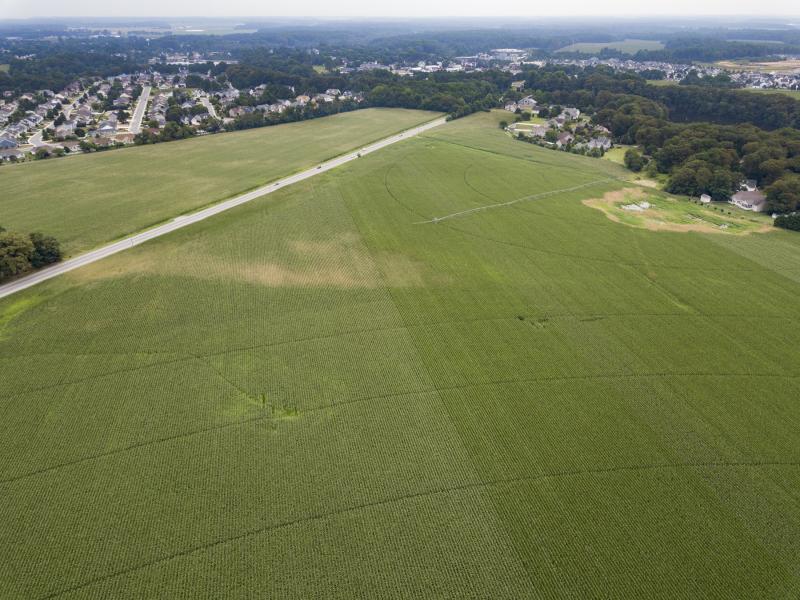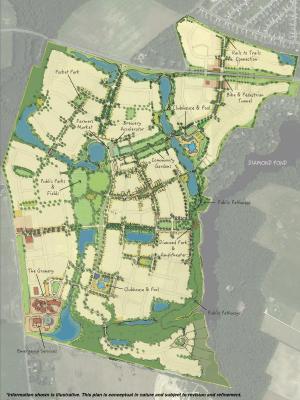Milton council tables Granary vote
A full house packed Milton library’s meeting room Feb. 7 as the town council held off on a vote regarding the annexation of 450 acres on Sand Hill Road, an area proposed to be built up as a 1,350-unit development called The Granary at Draper Farm.
Council has not set a date for a formal vote, with the next scheduled meetings set for either Thursday, Feb. 17 or Monday, March 7. The choice to table a vote was made due to significant public comment, which council members wanted to absorb and reflect on before making a decision.
While those commenting publicly were not necessarily against the annexation and development, there were concerns, mostly from residents of neighboring Bangor Lane, about how the development will affect them.
The Feb. 7 public hearing started with a presentation from Colby Cox, head of developer Convergence Communities. Cox, a native of Lewes whose family has owned the land on which the Granary would be built for nearly a century, said it has been identified as a growth area in the town’s comprehensive development plan, and the project would be much better if built within the town of Milton rather than under Sussex County jurisdiction. He said one of the reasons for seeking to zone the parcel as R-2 residential with a large-parcel development overlay was in order to make the development mimic the look of the existing town. Cox said 25 percent of the property would be left undeveloped as open space or woodlands, and the Granary will include a 3-mile walking trail connecting with the existing Rails to Trails through an underpass under Sand Hill Road. Cox said there will also be a vegetative buffer between the development and nearby Diamond Pond.
He said Convergence has tried to provide as much detail as it can, through boundary and topographic studies, review by the state’s Preliminary Land Use Service process, and studies done by the town’s special review committee and planning and zoning commission.
Cox said he wants the development to be a great place to live that will stand the test of time. He described the architecture of the homes as modern farmhouse. Besides a walking trail, Cox said the development will have some supportive commercial aspects, including an amphitheater, space for a farmers market, a working granary and what he called a brewery incubator, a small working brewery that would allow home brewers to produce and package beer on a larger scale.
Convergence officials have said the development will dedicate 55 acres of park and open space, including an athletic field, to the town. Cox said the only parts of the development that will remain private are the clubhouses and fitness centers. He said there will be electric vehicle parking stations throughout the development.
All during the annexation process, Convergence has proposed a 20-year buildout for the development. Cox said the buildout will be phased in, with the first phase likely to be on the northwest corner of the parcel.
Council members then had the chance to ask Cox questions. Councilman Sam Garde asked about the power supply to the development. The Granary would use Delaware Electric Cooperative, instead of Delmarva Power like the rest of the town. Cox and Town Manager Kristy Rogers said the reason for that is because the Granary property is located within DEC territory, as drawn up by the Delaware Public Service Commission which regulates utilities in the state. Mayor Ted Kanakos said he would like to see some kind of uniformity when it comes to the Granary’s electric rates, so citizens there are not paying higher or lower bills than the rest of the town.
Kanakos asked about the potential for flooding issues with the bike trail underpass. Cox said if that becomes a problem, other alternatives can be examined, but it is Convergence’s goal to have connectivity from the development to the town.
Kanakos also questioned Cox’s plan to designate the Granary as a special development district, a mechanism by which residents of the Granary would pay a levy on top of their property tax that will go toward paying for public infrastructure – such as police, town employees and equipment – needed to serve the development. Under this arrangement, the town would issue bonds, with the proceeds covering those costs. The town would then be paid back through the additional tax.
This does not include infrastructure such as roads or water and sewer hookups, which are the direct responsibility of the developer.
Kanakos said he was concerned the tax would make Granary residents become second-class citizens, and he questioned why the town should provide any kind of aid to the developer.
Cox said the tax is to help support public infrastructure, but it could be revisited once a master plan is submitted. He said money from the tax, which would eventually expire and would be around $1,500 to $2,000 annually, could help fund improvements such as additional sidewalks or a water tower on the Granary site. Cox said he has designated 5 acres of land on the Granary site for future town use. He said the plan is also for the Granary to have a master homeowners association with multiple homeowners associations underneath broken down by building type, such as condominiums, commercial space and single-family homes.
The public gets its say
The floor was then turned over to citizens, who filled the meeting room to capacity.
Michael Camasso, a resident of Bangor Lane, went first and asked why the development did not seem to have a plan for affordable housing. He said the homes seemed to be geared toward people coming from New York and New Jersey, but not to young Delawareans, who could not afford a house in this development. Camasso cited the special review committee’s cost-benefit analysis and said the lowest house prices in the Granary are higher than the current median home price in Milton.
Camasso then questioned the completeness of the cost-benefit analysis and said the development timeline only benefits the developer, while surrounding homeowners will be see a seemingly never-ending development process.
Cathy Orleman, also of Bangor Lane, asked where Granary residents would enter the property. Cox said the development will have entrances off Sand Hill Road and Gravel Hill Road. Orleman then asked Cox whether there would be construction, commercial or residential vehicles coming in through Bangor Lane, a small, two-lane road that dead-ends at a cul-de-sac. Cox said no, and added that unless residents of Bangor Lane want it, there is no plan to connect Bangor Lane to the Granary development; he said he is willing to put up signs advising people not to park on or drive onto Bangor Lane. Cox also said there would be no motorboats or jet skis on Diamond Pond.
Kent Sprunger, who lives on a corner lot on Lavinia Street across from the Granary parcel, said he is supportive of the project but would like to see more details. He said he’d like to see walking connectivity on Lavinia Street and reduced speed limits on Sand Hill Road, given all the new traffic that will be coming as the Granary is phased in.
Wayne Fisher of Bangor Lane said he did not want to see people walking or biking on Bangor Lane, which is a private road not dedicated to public use. About 40 property owners live on Bangor Lane, which would remain part of the county and is not included in the Granary annexation.
Nora Martin, a Bangor Lane resident, said she liked the project but still had some concerns. She said there should be more study of the pros and cons of storing grain on the site.
Allen Sangree of Union Street said under town code, an annexation this size could and should be taken to a public referendum to let the voters weigh in on whether they want the development. He said a petition with 112 signatures would be needed to take the issue to referendum. Kanakos asked why Sangree wanted the referendum, and Sangree said adding a development this large, which would double the size of Milton, could have political and economic repercussions. Kanakos said a referendum is not required, but if Sangree could get a petition with 112 signatures, there’s nothing Kanakos could do to stop him.
After the meeting, Cox said he was a little put off by discussion of a referendum, which could blow up and bypass months of work by the Convergence team and town officials. He said the town has done a comprehensive and thorough review of the annexation application.
Finally, Maurice McGrath of West Shore Drive said he favored the annexation because Cox actually came to the town and wanted to be a part of it, instead of going to the county and building whatever he wants. McGrath said if Milton does not annex the Granary parcel, Milton will still end up paying for it, as Milton’s police department will be the first responders. Chief Derrick Harvey has said if the Granary property is annexed in, the department will need six additional officers plus cars and equipment over the 20-year development period to serve the Granary. McGrath said by annexing the Granary parcel into Milton, the town will be able to control the growth.
Following public comment, Garde moved to table a vote on the annexation, which passed by 5-1 vote with Councilman John Collier voting no.
Ryan Mavity covers Milton and the court system. He is married to Rachel Swick Mavity and has two kids, Alex and Jane. Ryan started with the Cape Gazette all the way back in February 2007, previously covering the City of Rehoboth Beach. A native of Easton, Md. and graduate of Towson University, Ryan enjoys watching the Baltimore Ravens, Washington Capitals and Baltimore Orioles in his spare time.
























































